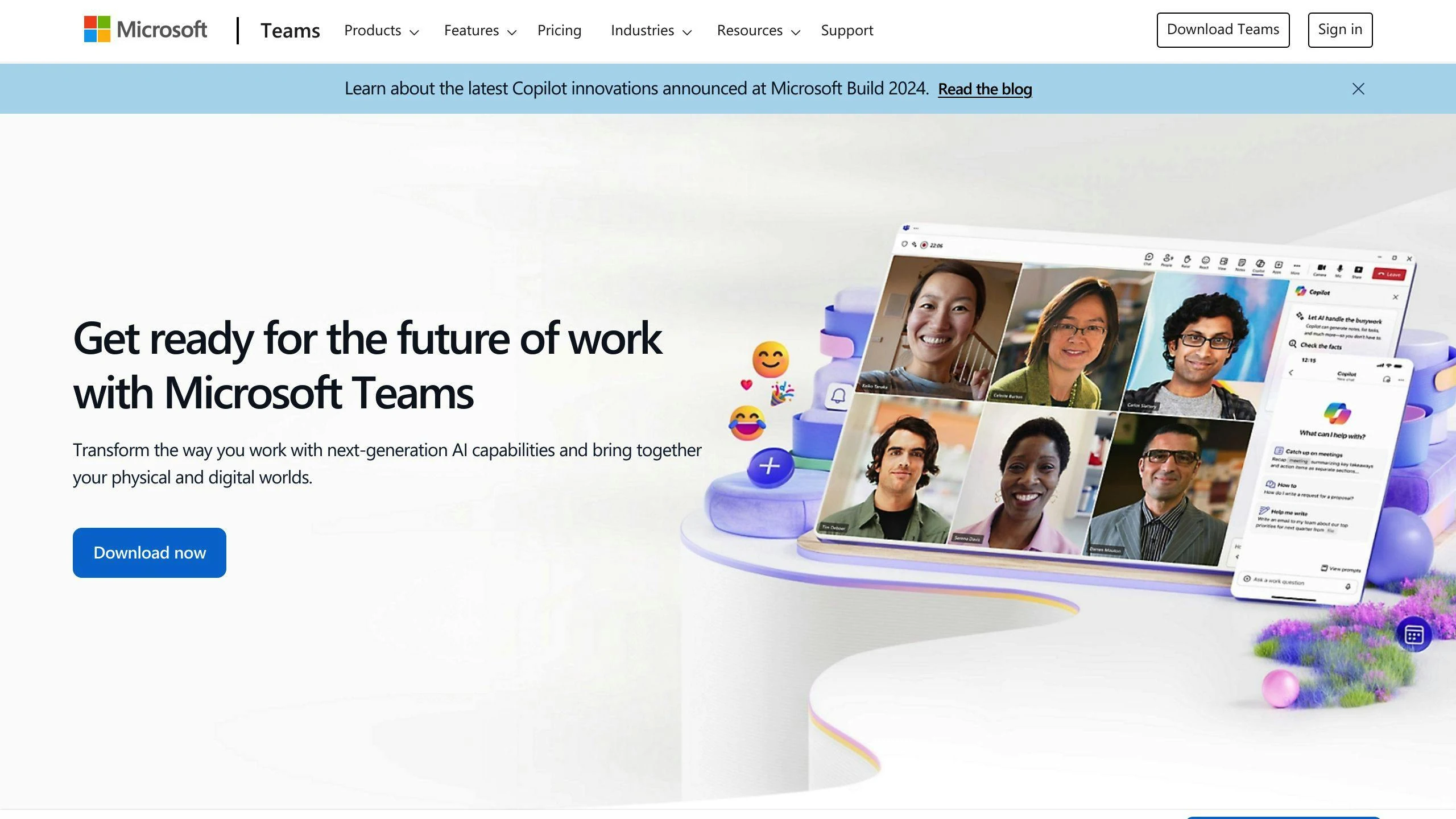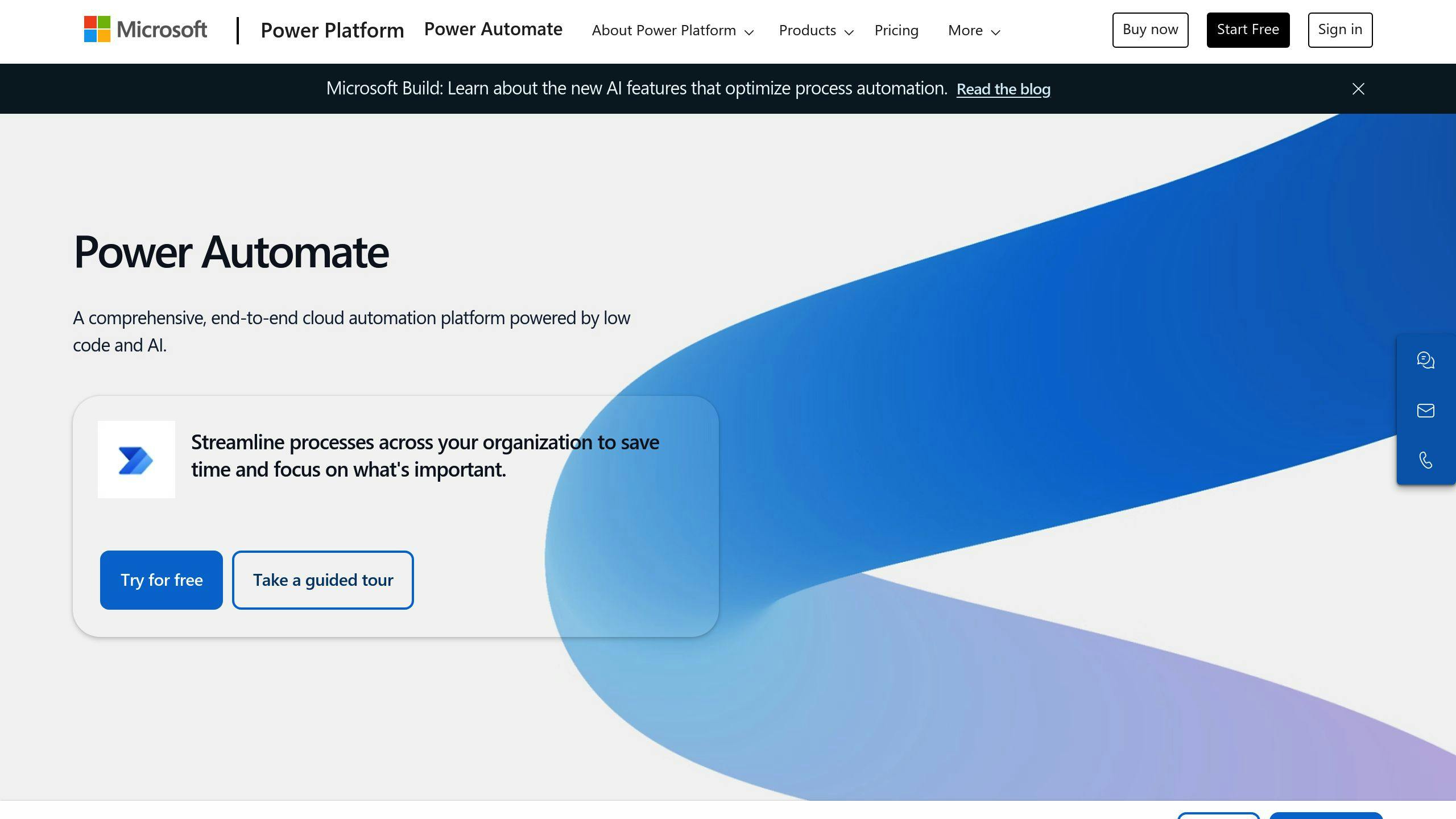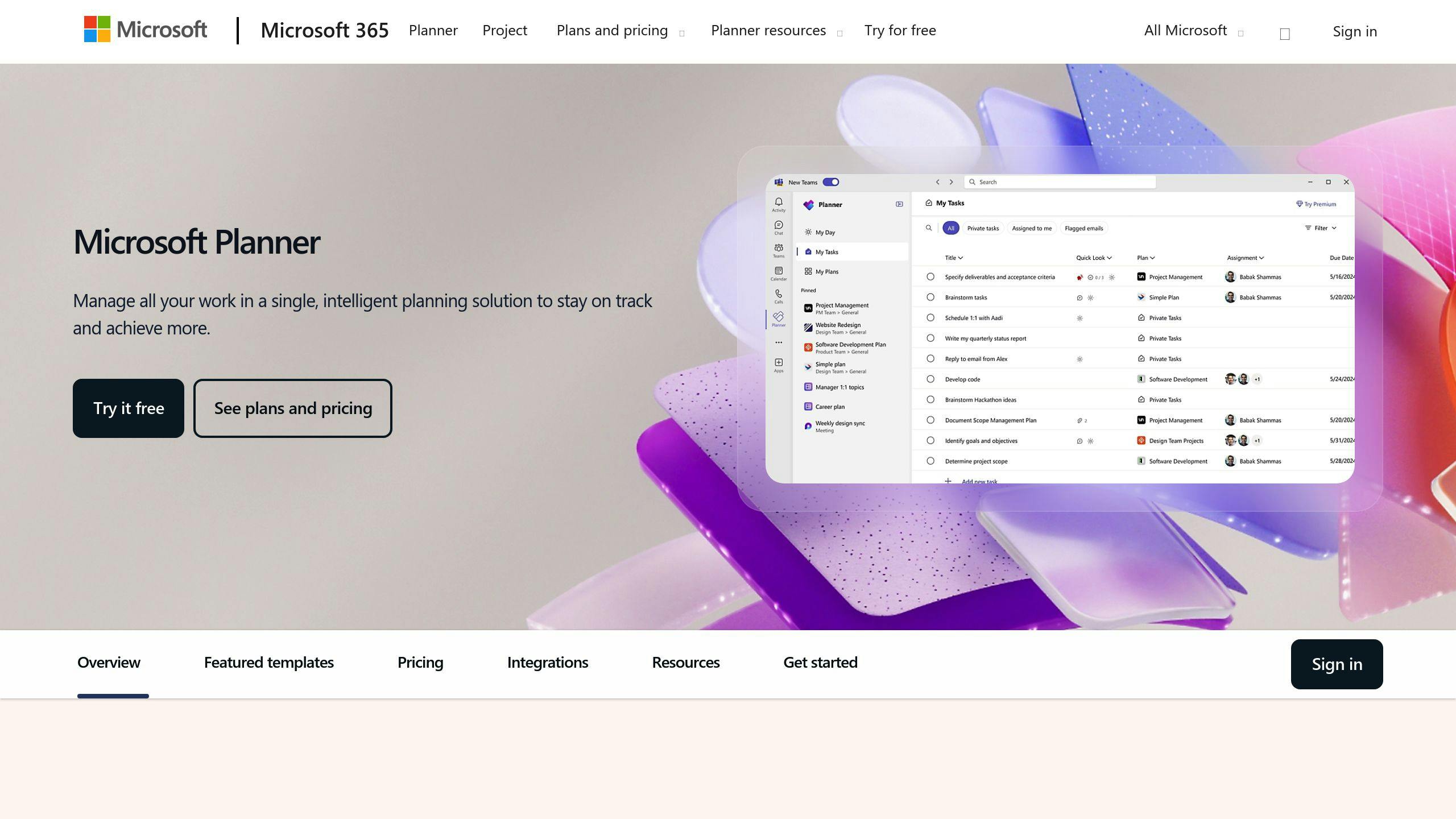Want to supercharge your project management in Microsoft Teams? Here’s how to create killer progress reports:
- Use templates
- Create a standard structure
- Automate with Power Automate
- Try the PPP method
- Add visuals
- Enable easy access and editing
- Connect with project management tools
- Set regular schedules
- Keep updates short and useful
- Use @mentions for follow-ups
Key benefits:
- Real-time updates
- Centralized information
- Easy collaboration
Who it’s for:
- IT Managers
- Project Managers
- Organizational Leaders
Quick Comparison:
| Tip | Benefit | Ease of Use |
|---|---|---|
| Templates | Consistency | Easy |
| PPP Method | Clarity | Easy |
| Power Automate | Time-saving | Moderate |
| Visuals | Quick understanding | Moderate |
| @mentions | Clear accountability | Easy |
Ready to level up your project communication? Start with these tips today.
Related video from YouTube
1. Use Microsoft Teams templates

Templates in Teams are your secret weapon for quick, consistent progress reports. They’re pre-built structures that save time and keep everyone in sync.
Here’s how to find and use templates:
- Go to Teams admin center
- Click Teams > Team templates
You’ll see two types of templates:
- Prebuilt: Ready-to-use, industry-specific templates
- Custom: Templates you create or modify
Want to tweak a template? Here’s how:
- Pick an existing template
- Click Add to create a new one
- Change the settings (name, descriptions, channels, apps)
- Click Apply, then Submit
Pro tip: Custom template changes can take up to 24 hours to show up for your team.
Templates aren’t set in stone. They’re flexible tools you can shape to fit your project.
For example, a large construction company used custom templates to manage their projects. They added channels for scheduling, budgeting, and compliance, which helped cut down on delays and boost efficiency.
2. Create a standard report structure
A consistent report structure in Microsoft Teams makes progress updates clear and easy to understand. Here’s how to do it:
Key parts of a progress report
Include these in every report:
- Project name and period
- Status (on track, at risk, off track)
- Accomplishments
- Upcoming tasks
- Risks and issues
- Budget status
- Action items
Why use the same format?
A uniform structure helps:
- Create reports faster
- Compare projects easily
- Spot issues quickly
- Make better decisions
Here’s a simple table format:
| Section | Content |
|---|---|
| Status | Project health (Green/Yellow/Red) |
| Achievements | Completed tasks and milestones |
| Next Steps | Upcoming work and deadlines |
| Risks/Issues | Current and potential problems |
| Budget | Spent vs. Allocated funds |
| Actions | Tasks for team members |
This structure makes your reports easy to scan and understand. It keeps everyone in sync and moving forward.
"Share more and be transparent in status reports. It gives your teams and clients the power of knowledge on projects."
Using this approach, you’ll create reports that keep everyone on the same page and focused on what matters.
3. Use Power Automate for automatic reports

Power Automate can streamline your progress reporting in Microsoft Teams. Here’s how:
Setting up automatic workflows
- Go to https://make.powerautomate.com/
- Click "Create" and pick "Scheduled Cloud Flow"
- Name your flow and set a schedule
- Add actions to gather data and create your report
You could set up a flow that:
- Grabs data from your project tool
- Builds a report in Excel
- Posts a summary in Teams
This keeps everyone in the loop without extra work.
Connecting Microsoft 365 tools
Power Automate plays nice with many Microsoft 365 apps. You can:
- Get data from SharePoint lists
- Make tasks in Planner
- Send Outlook email updates
- Post in Teams channels
Here’s a simple workflow:
| Step | Action |
|---|---|
| 1 | Get project data from SharePoint |
| 2 | Create report in Excel |
| 3 | Post summary in Teams |
| 4 | Create follow-up tasks in Planner |
This links your tools and automates reporting.
Pro tip: Check out pre-made templates in Teams. Just hit the "Automate" tab and click "Create from template" to find what you need.
4. Try the PPP method
The PPP method is a simple way to structure your progress reports in Microsoft Teams. It stands for Progress, Plans, and Problems.
What is PPP?
PPP is a reporting framework used by big companies like Skype, eBay, and Facebook. Here’s what it covers:
- Progress: What you’ve done since last time
- Plans: What you’re going to do next
- Problems: Any issues you’re facing
Using PPP in Teams
Here’s how to use PPP in Microsoft Teams:
1. Create a template: Make a Teams post with three sections: Progress, Plans, and Problems.
2. Keep it short: Use 3-5 bullet points per section.
3. Tag people: Use @mentions for specific tasks or issues.
4. Be consistent: Post updates weekly or bi-weekly.
Here’s an example:
Progress:
- Finished user testing
- Finalized Q4 budget
- Onboarded 2 new people
Plans:
- Launch new feature Friday
- Start Q4 campaign planning
- Schedule team training
Problems:
- Waiting on vendor quotes
- Need help prioritizing backlog
Colin Nederkoorn, CEO of Customer.io, uses a similar approach. He says: "You can cast a wide net to get help with your problems. They are then fully up to date on how you’re doing, and they know what your next efforts will be."
5. Add visuals to reports
Charts and graphs make your Teams progress reports clearer. Here’s how to add and optimize visuals:
Adding charts and graphs
To add visuals to Teams reports:
- Create charts in Excel or Power BI
- Paste visuals into Teams messages
- Upload chart images to Teams channels
Use bar charts for task completion rates or line graphs for project milestones.
Power BI visual creation:
- "Sales $" field = column chart
- "City" field = map visualization
- "Area chart" button = compare yearly sales
Make visuals pop
Tips for effective charts:
- Y-axis starts at 0
- Horizontal labels for bar graphs
- Use brand colors
- Keep it simple
| Chart Type | Best For |
|---|---|
| Donut | Progress percentage |
| Bar | Category comparisons |
| Line | Time trends |
| Gauge | Goal progress |
Edward Tufte said it best: "Above all else, show the data."
Make your data easy to grasp at a glance. Your team will thank you.
sbb-itb-8be0fd2
6. Easy Report Access and Editing in Teams
Teams makes working on reports together a breeze. Here’s how:
Team Collaboration
Use Teams’ features to your advantage:
- Set up a report channel
- Store templates in Files
- Tag teammates with @mentions
Quick Tip: Pin key reports to the top of your channel.
Access Control
Manage who sees and edits your reports:
| Who | Can Do What | Good For |
|---|---|---|
| Owner | Everything | Team leads |
| Member | View and edit | Regular team |
| Guest | Usually just view | Outside folks |
To set it up:
- Click the team name
- Hit More options > Manage team
- Go to Settings and tweak permissions
Smart Move: Check who has access regularly to keep things secure.
7. Connect with project management tools
Linking Teams with project management tools can supercharge your workflow. Here’s how:
Microsoft Planner: Your built-in buddy

Planner and Teams go together like peanut butter and jelly. To add it:
- Hit the + in a channel
- Pick Planner
- Make a new plan or use an old one
Now you can:
- Assign tasks (up to 11 people per task)
- Use different views: Grid (list), Board (Kanban), or Charts (progress tracking)
"Planner in Teams brings all your tasks and plans together in one spot. It’s like having your entire to-do list right where you chat."
Other tools in the mix
Planner’s great, but you’ve got options:
| Tool | What it does | How to hook it up |
|---|---|---|
| SharePoint | Manages docs | Auto-linked to Teams |
| To Do | Personal tasks | Built into Teams |
| BrightWork 365 | Heavy-duty PM | Plugs right into Teams |
To make these tools sing:
- Use SharePoint for your project files
- To Do for your personal task list
- BrightWork 365 when you need the big guns
8. Set regular report schedules
Consistent report schedules keep your team on track. Here’s how to do it:
Choosing report frequency
Pick a schedule that fits your project:
| Project Type | Suggested Frequency |
|---|---|
| Fast-paced | Daily or bi-weekly |
| Standard | Weekly |
| Long-term | Bi-weekly or monthly |
Product development teams often do daily check-ins. Helpdesk teams? Weekly updates might work better.
Using Teams calendar
Teams’ calendar is your friend:
- Create a recurring event for reports
- Set reminders
- Use "/remind" for alerts
Pro tip: Type "/remind" + details + "-recurring" for repeating reminders.
Keep it smooth:
- Start weekly for new projects
- Adjust as needed (maybe bi-weekly later)
- Go back to weekly near the end
The goal? Regular communication without meeting overload. Focus on purpose, not just frequency.
9. Keep updates short and useful
Want your Microsoft Teams progress reports to actually get read? Here’s how:
Write clear summaries
Use the PPP method: Progress, Plans, Problems. Start with a quick TLDR, then dive into details:
TLDR: Backend API 80% done. Frontend started. Minor delays from third-party issues.
Progress: 8/10 API endpoints complete. Plans: User testing next week. Problems: Waiting on payment gateway provider.
Focus on what matters
Highlight key info with bullet points and specific numbers. Use tables for easy comparison:
| Metric | Now | Goal |
|---|---|---|
| API Endpoints | 8/10 | 10/10 by Friday |
| User Stories | 15/20 | All by sprint end |
| Bugs | 3 critical, 7 minor | 0 critical at release |
Keep it short and sweet. As Baron Schwartz, VividCortex CEO, puts it:
"A proper approach should be: Informative and clear, yet brief; Frequent, yet not noisy; Honest, without needlessly airing dirty laundry."
Give your team the info they need, nothing more. They’ll thank you for it.
10. Use @mentions for follow-ups
@mentions in Microsoft Teams are like digital taps on the shoulder. They grab attention, assign tasks, and highlight issues in your progress reports.
Assigning tasks
@mentions are your go-to for task assignment. Why? They:
- Notify directly
- Show clear responsibility
- Make tracking easy
To assign a task:
- Type @ + name
- Pick from the list
- Describe the task
Example:
@Sarah Chen Update API docs by Friday for next week’s client demo.
Pointing out issues
Use @mentions to flag problems or updates:
| Scenario | Example @mention |
|---|---|
| Blocker | @David Lee Payment gateway down. Blocking checkout testing. Investigate ASAP? |
| Critical update | @Team Client moved deadline up a week. Sprint plan adjustment needed. Meeting in 30. |
| Urgent feedback | @Emma Watson New design mockups uploaded. Need approval in 2 hours to stay on track. |
Don’t overuse @mentions. They’re for important or time-sensitive stuff only.
Pro tip: Create custom tags for groups (e.g., @frontend-team, @qa-testers) to notify specific teams without pinging everyone.
Conclusion
Progress reporting in Microsoft Teams can supercharge your project management. Here’s what you need to remember:
- Use templates
- Automate with Power Automate
- Add charts and graphs
- Collaborate in Teams
- Connect with other tools
- Set regular schedules
- Keep it short and sweet
- Use @mentions
Good progress reporting isn’t just box-ticking. It’s about trust, spotting problems early, and keeping projects on track.
"If I come across a project that’s always in green status, I question it… I’ve never come across a project that is constantly 100% in green status." – Adriana Girdler, Project Management Expert
Don’t sugarcoat issues. Flag them. It shows you’re on top of things.
Use these tips and you’ll boost transparency and accountability. Your team will be in sync, stakeholders in the loop, and projects more likely to succeed.
Ready to level up your project communication in Teams? Start now.
